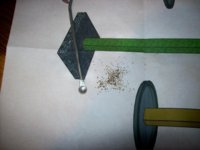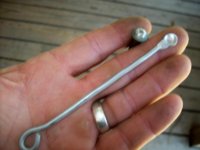If you plan on selling seed packets, or distribute seed packets on a frequent basis, you can improvise a measuring tool to scoop out ~100 seeds. The problem I found with most improvised measures is that they tend to be made of materials that can hold an electrostatic charge. This means that a few seeds from one variety can easily cling to the measure, when moving on to the next variety. Bad.

Since I make cheeses from time to time, I purchased a tiny set of measuring spoons. They are labeled with meaningless measures, such as "smidgen." I measured the tiniest one, which came out to about 1/20 teaspoon. (That's about the right amount of mesophilic culture to add for a 2 pound cheese.)
2/3 of this tiny spoon measures a bit over 100 tobacco seeds of N. tabacum--probably 30-50 of N. rustica. When I fill a seed packet, I simply scoop a level measure of this tiny spoon, and know that it's between 150 and 200 seeds. Because it's made of stainless steel, there's no electrostatic charge on the surface, so no sleeper seeds remain on it.
I purchased this at http://www.cheesemaking.com/store/p/299-Mini-Measuring-Spoon-Set.html for ~$6, though you may find them elsewhere for less.
Plan B is to buy a $300 digital analytic scale, and weigh out between 0.01 and 0.02 grams to have 100+ seeds.
All bets are off (count-wise) if you have much debris mixed with the seed. Debris should be avoided anyway, since it is capable of carrying viruses, like TMV, which are not transmitted in pure seed.
For quickly removing nearly all debris, as well as under-size seeds, use two screens (filters). N. tabacum seeds are about 500 microns. You place a 400 micron filter onto a 5 gallon bucket (it rests on the rim), nest a 600 micron filter on top of that, then crush the dried pods over the assembly. After a few good shakes, discard what's on top (trapped by the 600 micron filter), SAVE what's held in the 400 micron filter, and discard whatever has made it into the bottom of the bucket. The finished seed looks like clean, ground coffee.

The filters are only $4.31 each, and available from US Plastics Corp.
400 micron: http://www.usplastic.com/catalog/item.aspx?itemid=37445
600 micron: http://www.usplastic.com/catalog/item.aspx?itemid=37442
Each time I've finished using the filters for a particular variety, I take the bucket and filters outside, and forcefully hose them clean with the garden hose. By holding the white polyethylene filter up to the sky, you can see if there are any remaining seeds trapped in the mesh. The filters should be thoroughly dried before using them again.
The packets. I use the tiny 2"x4" ziplock bags that are available in the handicraft (bead jewelry) section of Walmart, inserted into a 2-1/2"x4-1/2" paper envelope, available at office supply stores. They can be nicely labeled with Avery 55463 laser labels, which are 2"x4" "shipping labels."
If you place a single packet of seed into an ordinary letter envelope, it will be run through the USPS automated cancellation machine, and some of the seed will be crushed, leaving tiny oily smears on the walls of the ziplock. To avoid this, you can place it into a bubble-padded envelope, or simply insert a cut-to-size rectangle of fine bubble-wrap into the envelope. First class postage on a Jiffy-mailer runs between $1.50 and $1.80.
There are no USPS restrictions on mailing seeds within the US. If you intend to send seed to another country (or into the US from outside), you may need a certificate of sanitation from the local Ag Extension agent. Most countries' customs agents will not accept seed that includes plant debris--if they happen to look at it. Although it is often possible to get dirty seed past customs, it increases the very real risk of propagating troublesome plant diseases from one region of the world to another. [In the late 1800s, an American soil organism was carried into the wine regions of France and threatened to completely destroy the French wine industry. All infected French varieties were killed by the fungus. The only remedy was to import native American grape varieties--resistant to the fungus--to France, then graft the French wine varietals onto the American roots.]
I realize that everyone has his or her own method of sending off seed. The above is simply how I do it.
Bob
Since I make cheeses from time to time, I purchased a tiny set of measuring spoons. They are labeled with meaningless measures, such as "smidgen." I measured the tiniest one, which came out to about 1/20 teaspoon. (That's about the right amount of mesophilic culture to add for a 2 pound cheese.)
2/3 of this tiny spoon measures a bit over 100 tobacco seeds of N. tabacum--probably 30-50 of N. rustica. When I fill a seed packet, I simply scoop a level measure of this tiny spoon, and know that it's between 150 and 200 seeds. Because it's made of stainless steel, there's no electrostatic charge on the surface, so no sleeper seeds remain on it.
I purchased this at http://www.cheesemaking.com/store/p/299-Mini-Measuring-Spoon-Set.html for ~$6, though you may find them elsewhere for less.
Plan B is to buy a $300 digital analytic scale, and weigh out between 0.01 and 0.02 grams to have 100+ seeds.
All bets are off (count-wise) if you have much debris mixed with the seed. Debris should be avoided anyway, since it is capable of carrying viruses, like TMV, which are not transmitted in pure seed.
For quickly removing nearly all debris, as well as under-size seeds, use two screens (filters). N. tabacum seeds are about 500 microns. You place a 400 micron filter onto a 5 gallon bucket (it rests on the rim), nest a 600 micron filter on top of that, then crush the dried pods over the assembly. After a few good shakes, discard what's on top (trapped by the 600 micron filter), SAVE what's held in the 400 micron filter, and discard whatever has made it into the bottom of the bucket. The finished seed looks like clean, ground coffee.

The filters are only $4.31 each, and available from US Plastics Corp.
400 micron: http://www.usplastic.com/catalog/item.aspx?itemid=37445
600 micron: http://www.usplastic.com/catalog/item.aspx?itemid=37442
Each time I've finished using the filters for a particular variety, I take the bucket and filters outside, and forcefully hose them clean with the garden hose. By holding the white polyethylene filter up to the sky, you can see if there are any remaining seeds trapped in the mesh. The filters should be thoroughly dried before using them again.
The packets. I use the tiny 2"x4" ziplock bags that are available in the handicraft (bead jewelry) section of Walmart, inserted into a 2-1/2"x4-1/2" paper envelope, available at office supply stores. They can be nicely labeled with Avery 55463 laser labels, which are 2"x4" "shipping labels."
If you place a single packet of seed into an ordinary letter envelope, it will be run through the USPS automated cancellation machine, and some of the seed will be crushed, leaving tiny oily smears on the walls of the ziplock. To avoid this, you can place it into a bubble-padded envelope, or simply insert a cut-to-size rectangle of fine bubble-wrap into the envelope. First class postage on a Jiffy-mailer runs between $1.50 and $1.80.
There are no USPS restrictions on mailing seeds within the US. If you intend to send seed to another country (or into the US from outside), you may need a certificate of sanitation from the local Ag Extension agent. Most countries' customs agents will not accept seed that includes plant debris--if they happen to look at it. Although it is often possible to get dirty seed past customs, it increases the very real risk of propagating troublesome plant diseases from one region of the world to another. [In the late 1800s, an American soil organism was carried into the wine regions of France and threatened to completely destroy the French wine industry. All infected French varieties were killed by the fungus. The only remedy was to import native American grape varieties--resistant to the fungus--to France, then graft the French wine varietals onto the American roots.]
I realize that everyone has his or her own method of sending off seed. The above is simply how I do it.
Bob




